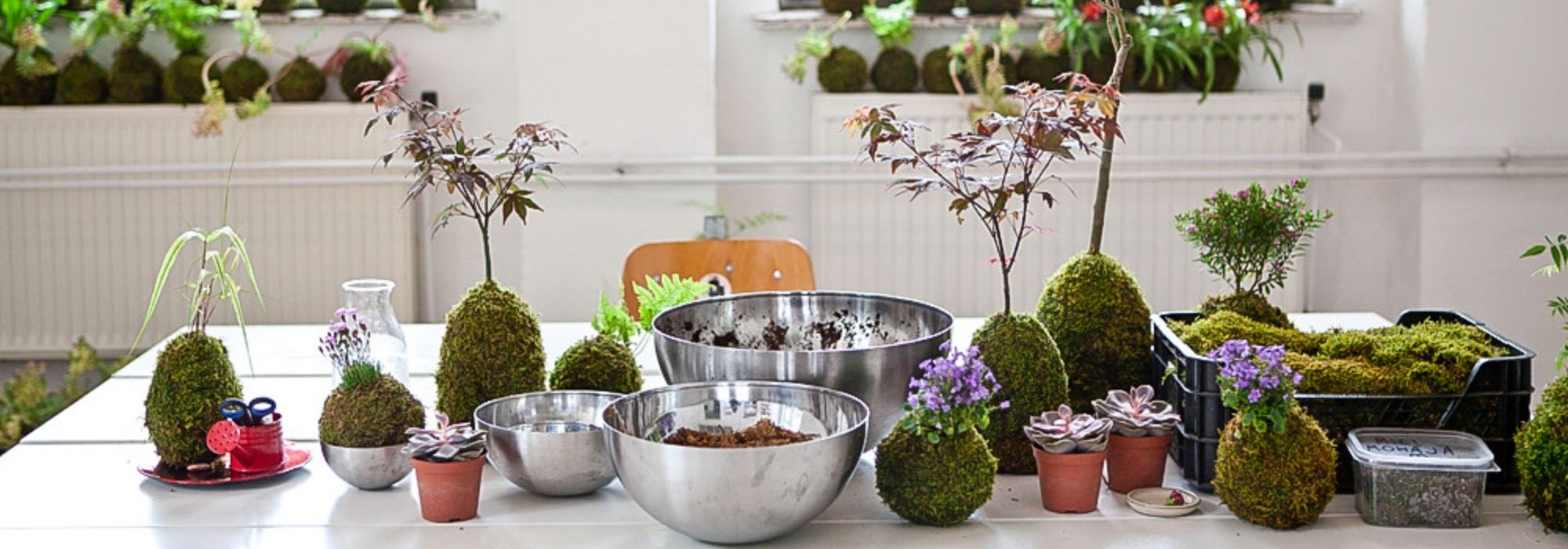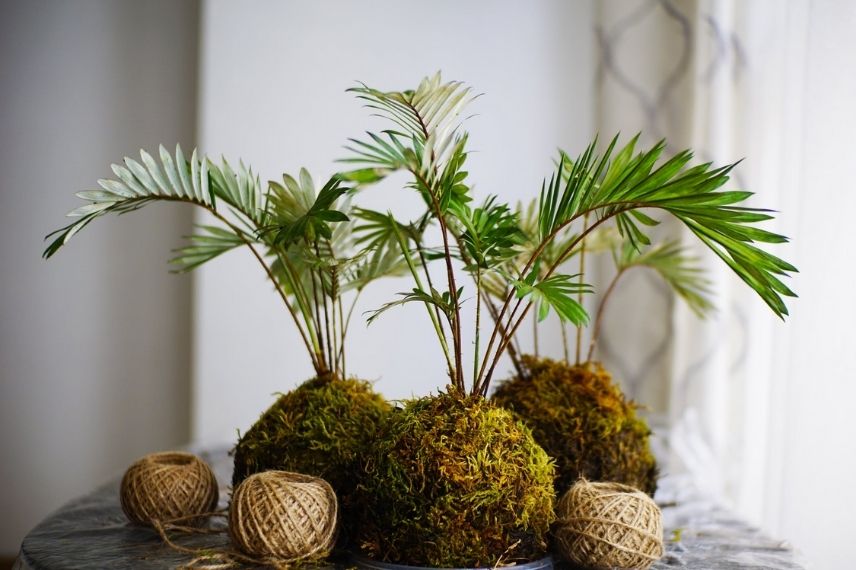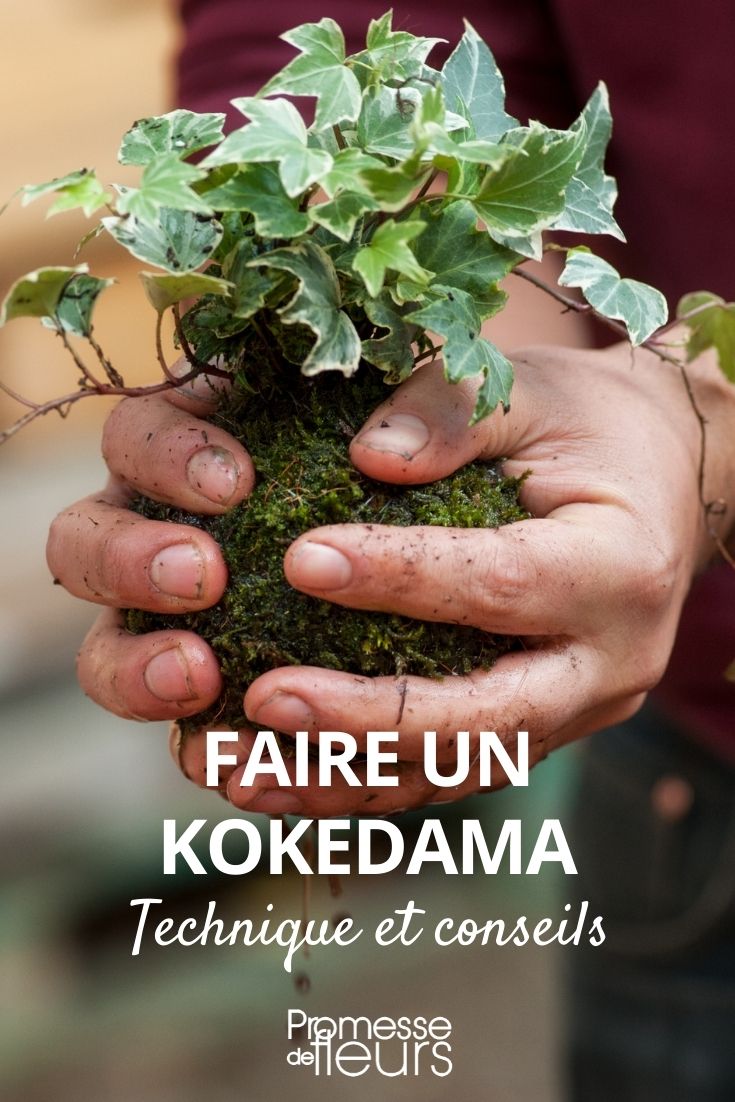
How to make a kokedama?
Components, manufacturing and maintenance
Contents
First appearing in the 1990s, kokedama is a Japanese floral art, designed to bring nature into homes. Between bonsai and ikebana, it is a moss sphere on which plants thrive. “Koke” means moss and “dama” means sphere, but also jewel.
Rich in symbolism, its creation is highly codified if one refers strictly to traditional techniques. Fortunately, these constraints can be relaxed to make practising this art accessible to beginners, as well as to experienced gardeners.
We will take a close look at essential components of kokedama (plant, moss and substrate), before guiding you step by step through making one and offering a few watering and care tips.
What are the three essential components of kokedama?
Kokedama consists of three elements: a plant, moss and substrate. From these components, recipes are declinate into hundreds of possible combinations, even though plant choice determines nature of substrate and of moss.
For a plant composition, favour hardy plants easy to grow, such as fern (Davallia Canariensis), cacti (Echeveria Agavoides ‘Ebony’), euphorbias (Euphorbia Cornigera), ivy, dwarf palm, or Asparagus Plumosus or Asparagus Falatus. For a floral composition, you can opt for orchid or hosta. Naturally, it is also possible to compose a mix by combining, for example, fern and ivy.
While hundreds of mosses exist in Japan, choice is much more limited in Europe. Generally, kokedama is built with these species: Rhacomitrium canescens, Hypnum plumaeforme, varieties of Thuidium or the very hardy Ctenidium sp, perfect for adapting to sunny conditions. Naturally, it is also possible to harvest it directly from garden or forest: simply clean it, remove dirt and small pests (snails, slugs…).
Finally, substrate traditionally used for kokedama is a mix of Ketoh (4 parts), akadama (2 parts) and sphagnum (1 part), but you can also prefer a mix of clay, compost and sphagnum. For this mix, soak clay in water two days beforehand so it dissolves, then add the three elements in equal proportions, before adding compost and sphagnum until a sticky, fibrous mix is obtained.

Read also
Japanese garden: 10 iconic shrubsHow to make a kokedama?
To make a kokedama, beyond the three essential components, you need to gather a little equipment: a horticultural fleece, black or green cotton thread, a wooden or metal root comb, copper or aluminium wire, scissors and a sprayer.
Next, the kokedama creation phase begins:
- Remove the plant from its pot and moisten the soil with a sprayer. Untangle the roots and remove excess soil with the root comb. If necessary, trim overly long roots. Recover removed soil, moisten it and finalise the sphere
- Gently place the plant on the fleece. Cover the entire sphere with the fabric. Hold the thread with the index finger and make full turns, spaced 2 cm apart. Fold the fabric back to create a turn and pass the thread over it to press it onto the sphere, before tying a knot.
- Take the moss and moisten both sides, with the sprayer to make it more supple. Starting from the top, place it on the sphere and hold it in place with a few turns of thread. Repeat as many times as necessary to cover the whole sphere.
- Tuck the moss inside, so the sphere looks neater. Similarly, trim with scissors any pieces of moss that stick out to give a smooth base.
- Place the plant composition on a slate, a lacquered wooden board or a ceramic piece. Note that it is possible to suspend it.

When and how to water a kokedama?
When to water?
Frequency of watering depends on seasons: traditionally, it is once a week in winter and rises to two to three times in summer. As a guideline, wait until kokedama feels light.
How to water?
Unlike bonsai, which demand constant care, kokedama is very easy to maintain, as it only needs watering. But this requires some finesse. Indeed, avoid getting moss wet as much as possible, otherwise it may turn brown. Ideally, place a small funnel at the centre of the sphere to pour water at room temperature and low in minerals.
Patricia’s tip: use rainwater to water kokedama. If not available, when using tap water, leave it for 24 hours to allow chlorine to dissipate.
How to care for it?
Generally, this plant composition does not like direct sunlight; it is preferable to place it behind a sheer‑curtained window, in a non‑air‑conditioned room and away from draughts. In winter, you can draw the curtains back, but in summer you should move it back a few metres.
Normally, kokedama is shaped on a sphere about 10 cm in diameter. On this basis, plant height should be limited to 30 cm to preserve its elegance and lifespan. Although it depends on the plant chosen, lifespan typically ranges from one to two years.
- Subscribe!
- Contents
































Comments